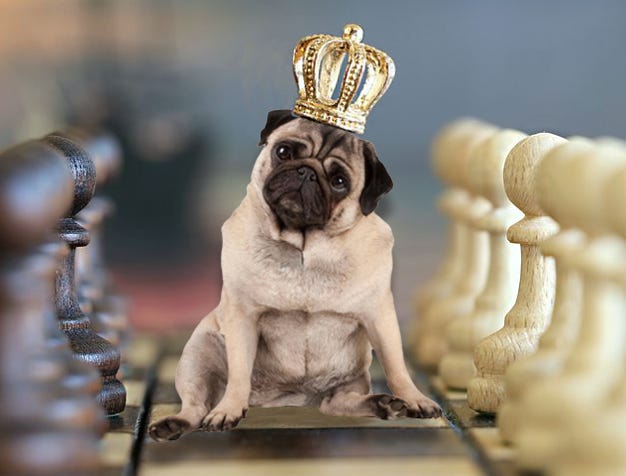UP YOUR DOG SHOW GAME
Helping Breeders &
Exhibitors Succeed in the Show Ring

LEARN HOW

SELECTING
CONFORMATION
PUPPIES
By Theresa Mullen
Is there a method or a "secret" to picking puppies?? I KNOW there is a secret to picking puppies---or should I say SEVERAL secrets. I'll try to outline all the things that I use when evaluating puppies.
Don't start to evaluate the litter too soon. I think many breeders concentrate WAY TOO MUCH on what they see at 3, 4, 5 and even 6 weeks. It's good to watch and observe behavior and temperament and generally which ones are bold and pushy and have great general attitude----BUT, don't try to analyze and grade puppies too young. They ALL look good at 6 weeks, unless you are extremely experienced in looking at 100's of puppies and can know when you see serious problems. Concentrate on getting the puppies used to being up on the grooming table and relaxing up there AND work with the tails so you can get a realistic idea of what they look like stacked on the table.
I like to look at puppies three times----first at 7 to 8 weeks, then at about 10 weeks, after the ears are cropped---then again for the final time at about 11 to 12 weeks. It's important to get in your mind the "picture" of what a typical puppy looks like at these ages. This is helpful when comparing size, maturity and bone and substance at these ages. Many people have never seen a "great" litter that had many Champions in it, or even a litter that had a Top Twenty dog in it. Try to ask to be there when a top breeder is grading their or someone else's litter and listen to their critique and what the overall litter looks like. Experience is the greatest teacher.
The first thing I do is ask to see the puppies running around in an area that I can observe them moving around on their own and how they interact with one another. If it's a large litter, say 8 or over, I may want to see them all briefly and then divided into smaller, more manageable group size---say 4 or 5. I'm looking for the puppy that carries himself with style and attitude with tail up and moving boldly around. I just take a chair and sit somewhere in the room where I'm out of the way and can see all the puppies moving around. I get a general "feel" for which puppies "strike" me as outstanding and having great quality.
Next, each puppy is put up on the grooming table. All ribbons and collars are removed---as I want to SEE how the neck flows into the wither and the arch of the neck without being distracted by colored ribbon, collars or anything that will "cut up" the neck and wither area. A small, think black (for black puppies) or dark brown ( for red puppies) collar works best for me. I have someone stack the puppy on the table---without bait, hopefully---so the puppy is just standing there, relaxed, and just THERE!
In my Doberman puppies I am looking for:
1. Balance and harmony overall.
2. A great head.
3. A smooth puppy overall---no wrinkles over the withers.
4. A dead level topline from the withers to the tail.
5. A VERY flexible and WILLING tail----one that is set on right, with move ability and the puppy has the attitude that he doesn't mind the tail being manipulated and touched.
6. I am looking for the front assembly to be very angulated in shoulder placement and especially the upper arm placement and length. This is a SERIOUS problem in our breed---straight upper arms, short upper arms and a combination or both. If the puppy is straight or shows an upper arm angle that is JUST acceptable if he were an adult---you can bet the upper arm will be too straight once the puppy is mature and an adult. The angulation---both front and rear assemblies---will get steeper on the great majority of lines. A few lines stay the same, and even fewer seem to get more----but I think 90% of the lines will LOOSE angulation as they mature.
SO----look for front assemblies that are angulated properly---even to the extreme, if possible. This is the one most serious mistake most people make when evaluating puppies. They look for the puppy that has ADULT proportions. This is a very difficult concept to go against----looking at puppies DIFFERENTLY than adults---but it has been very successful for me with a variety of lines.
The body should be deep---almost too deep if you were looking at an adult. The deep body makes the legs look too short legged. But, for me this is a good thing. When puppies are "tall, leggy and not deep and full" through the brisket, with depth and spring of rib and nice width through the loin----the "tall drink of water" look continues to be just that----often being taller than long, more slab sided, instead of beautiful spring of rib and proper loin development.
The front legs should be straight as they leave the body and proceed to the pasterns and the foot. The two middle toes should rest "ever so slightly" out---with moderate width between the legs. The elbows should lie close to the body---but not pinched under the body with the front legs toeing out. The brisket should be deep and "hanging" between the front legs. From the side the puppy should show beautiful rounded forechest---moderate is good. Puppies that have none is not good to me. It signals that the front assembly is probably straight and shoved too far forward.
7. The rear assembly should be scrutinized like the front. The croup should be just ever so slightly sloped----almost imperceivable. The tail set should be proper---with the puppy carrying the tail at 1 to 2 o'clock when moving around happily. The croup should be approximately the same length as the ischium (the point of bone right beneath the tail) to the stifle and the same from the stifle to the hock. The stifle should have MUCH turn at this puppy age, hocks perpendicular to the ground and short. Remember, most lines will LOOSE angulation----front and rear----and will be straighter than the puppy angulation. This is why it is important to look for more exaggerated angles in a puppy. Pasterns and hocks should look short and firm.
ANY puppy that toes in or severely toes out will be graded PET by me. Toeing in is VERY faulty in a young puppy. Toeing out---if it is ever so slightly, often corrects itself as the body widens and the puppy matures---as the elbows will be pushed out slightly and this in turn allows the front legs to correct and turn more straight ahead. Hocks that turn in (cow hocked) or out (bandy legged) to any extent will probably remain and get more obvious as the puppy matures.
I personally don't think breeders are critical and brutal enough when grading their puppies. ANY deviation that is pronounced at this age will be magnified as the puppy gets older.
I grade ANY PUPPY A PET that:
- Has a poor head.
- Toes in to any degree at this age.
- Toes out SEVERELY---if this is slight, it is not as severe a fault as toeing in to me.
- Has a shallow depth of body or concave brisket/forechest.
- Is "slab sided" with lack of spring of rib and width over the top.
- Has a poor "neck into withers" junction---any "DIP" BEFORE the wither is definitely OUT.
- Any DIP pronounced---after the wither, where the vertebrae change direction---will get worse and is highly heritable.
- I pay close attention to "rough and wrinkling" neck into wither----if pronounced, it's a pet.
- ANY pronounced topline problems are out----rounded backline ("wheel-back")---sagging back to a marked degree---sloping off of the croup significantly---rounded croup is out---low tail-set it out---"squirrel tail" is NOT good, but if extremely good elsewhere I will take a good, hard look at the potential of the puppy---cow-hocked or bandy legged are out----sickle hocks are out.
- Significantly poor feet and/or pasterns are out.
- Lack of bone and substance are out.
- Puppies that stand off and won't come to people at this age are out.
- Puppies that show no exuberance and "love of life" at this age is NOT GOOD---in my own litters, these puppies are pets.
In my opinion, in a litter of 6 to 8, out of two outstanding parents and well bred----if this litter were to produce one that conforms to my scrutiny that would be what I consider a "TOP SHOW PROSPECT"!!
There may be 2 or 3 that are "POSSIBLE" Show Prospects.
That is a "GREAT" litter. I don't grade or sell any puppy as a show prospect that I personally wouldn't buy/train/put time into/spend money and blood, sweat and tears over/show.
Too many people either don't know what they are looking at and refuse to either hire or ask other experienced breeders to grade their litter for them. This is a big mistake. Also, don't make decisions based on 10 opinions from people who DON'T KNOW!!!!! Why ask an opinion from someone who hasn't been where you want to be in your breeding program. Ask the "experienced" breeder/exhibitor who has been successful in grading/buying really good Dobermans.
DON'T BE SENTIMENTAL!!!! Sentimentality is the downfall of breeders. It causes breeders to make poor decisions and rationalize their decisions. Don't do it. Be honest with yourself and with your litter.
Be realistic with your litter. A nice, average Champion bitch bred to a good producing sire will probably produce a nice litter with a Champion prospect in it. It more than likely will not produce a litter of ALL Champions that contain half of them "Specials".
Don't sell puppies as show prospects that are marginal----it's not worth the heartache that this decisions causes the new owner and you as a breeder. It is so disappointing to talk weekly to people who have one of your dogs that continues to loose. It's better to be "brutal" in grading and place that one "STAR" into a great show home and get the "winning calls" every week.
Be critical----be brutal----don't be sentimental----be realistic---when grading puppies. This is my "NUMBER ONE" Secret to breeding/grading success.
About the author: Theresa Mullen of Terrylane Doberman Pinschers has been devoted to the serious breeding and exhibiting since 1967. Her Dobermans include many Doberman Pinscher Club of America Top Twenty dogs; Best In Show winners and Specialty Show winners. DPCA Superior Quality Specimen’s, Stud Dog winners, DPCA Class winners as well as Obedience titled Dobermans. She has bred many Champions from a very limited and select number of breedings—proving you can breed the very highest calibre of Dobermans without having to breed large quantity.
Theresa’s philosophy on breeding Dobermans revolves around the “Strength of the Family” both Sire Line and Maternal Family, and its strong influence on an animals ability to successfully reproduce itself.